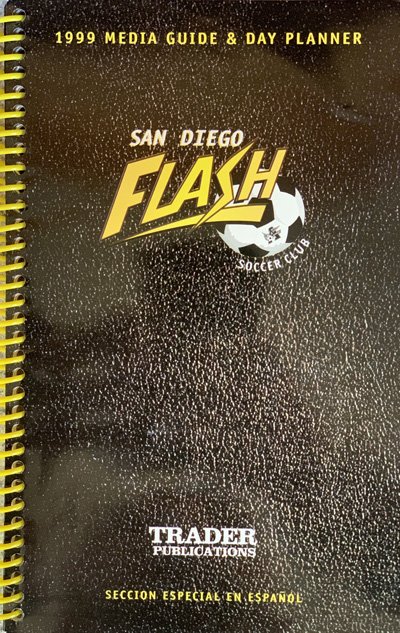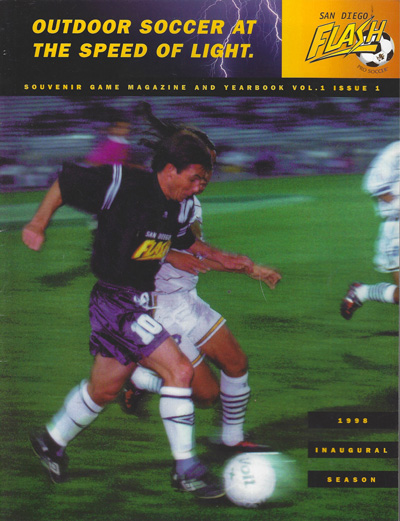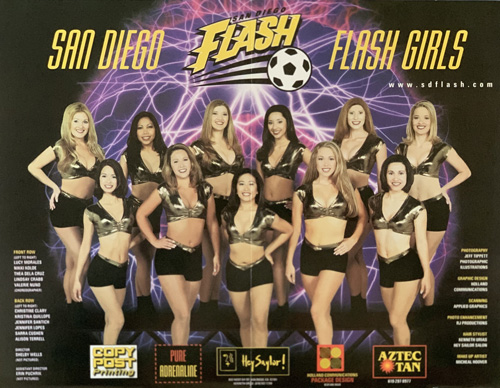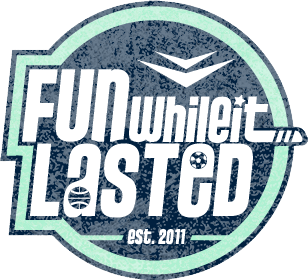USISL/USL A-League (1997-1999)
Tombstone
Born: 1998 – The Colorado Foxes relocate to San Diego, CA
Folded: 2001
First Game: April 11, 1998 (L 2-0 vs. Seattle Sounders)
Last Game: September 29, 2001 (4-1 @ Vancouver Whitecaps)
A-League Championships: None
Stadia
1998: DeVore Stadium (7,200)11998 United Systems of Independent Soccer Leagues Media Guide
1999-2001: Douglas Stadium (5,900)22001 United Soccer Leagues Media Guide
Marketing
Team Colors: Black, Yellow & White31998 United Systems of Independent Soccer Leagues Media Guide
Cheerleaders: The Flash Girls
Ownership & Affiliation
Owners:
- 1998-2001: Yan Skwara, et al.
- 2001: United Soccer Leagues
Major League Soccer Affiliation:
- 1998-2001: Los Angeles Galaxy
- 1999: San Jose Clash
- 2000-2001: San Jose Earthquakes
Attendance
Note: We are missing the league-wide attendance figure for the USL A-League for the 2001 season.
Tilting your mobile device may offer better viewing.
Sources: 1999, 2000, 2001 & 2002 USL Media Guides
Background
The San Diego Flash were a 2nd Division professional soccer club that competed in the United Soccer League’s A-League from 1998 through 2001. At the time, the A-League was the second highest level of outdoor soccer competition in the United States, operating one level beneath Major League Soccer.
After playing their debut season at Southwestern College’s Devore Stadium in 1998, the Flash moved to Douglas Stadium at Mesa College for their final three seasons from 1999 to 2001.
In Competition
The Flash were a strong entry on the field, never suffering a losing season or missing the playoffs. San Diego’s won the A-League’s Pacific Division and advanced to the playoff semi-finals in 1997 and again in 1998. The Minnesota Thunder eliminated the Flash in the semis both years. 2000 and 2001 brought second place division finishes and repeat playoff defeats at the hands of the Vancouver Whitecaps.
During the Flash’s first season in 1998 the team signed a pair of significant rookies that had gone overlooked by Major League Soccer clubs. Defender Jimmy Conrad signed his first pro contract with the Flash after playing on UCLA’s 1997 NCAA national championship team. Goalkeeper Joe Cannon was a standout for the Santa Clara Broncos. After spending most of 1998 with the Flash, both Conrad and Cannon would go on to join Major League Soccer’s San Jose Clash/Earthquakes franchise in 1999 and help anchor the Earthquakes’ 2001 MLS Cup championship team. Conrad won MLS Defender of the Year honors in 2005 as a member of the Kansas City Wizards and earned 27 international caps with the U.S. National Team between 2005 and 2010. Cannon earned the MLS Goalkeeper of the Year Award in 2002 with the ‘Quakes and again in 2004 with the Colorado Rapids.

Off-Field Problems & Demise
The Flash’s four-year run was marked by grand but under-funded aspirations. In 1998, the Flash reportedly had the largest budget in the 28-team A-League at $975,000 and lost $400,000.4Kirkpatrick, Cliff. “Fallbrook’s Peacock helps save the Flash”. The North County Times (Oceanside, CA). November 1, 1998 The Flash almost folded in November 1998 for lack of ability to post a $75,000 letter of credit owed to the United Soccer Leagues. Yet club founder Yan Skwara was quick to speak of his ambition to bring Major League Soccer to San Diego.
Over the next two years Skwara would seek to make the Flash a public traded company to raise $10M in capital for a soccer-specific stadium, enter an indoor version of the Flash into the wintertime World Indoor Soccer League, and acquire a second A-League franchise in Sacramento.5Cave, Andrew. “US soccer team will kick off on Wall St.” The Daily Telegraph (London, England). January 4, 2000 None of these ideas panned out, though Skwara briefly controlled the A-League’s ill-fated Sacramento Geckos in 1999.
By the spring of 2001 Flash investors were financially exhausted. On April 11th, 2001 – three days before the season opener for the Flash’s fourth season in the A-League – Skwara announced that the club did not possess the funds to play the season.
The United Soccer Leagues assumed management of the Flash on an emergency basis and delegated local operations to the La Jolla Nomads youth soccer organization. Operating on a shoestring, the Flash put together another winning season (14-11-1) but finished last in the league in attendance (580 fans per game). With no new investor found, the San Diego Flash went out of business at the end of the 2001 season.
A semi-pro brand revival of the Flash played in the National Premier Soccer League from 2011 through 2015.
San Diego Flash Shop
Downloads
April 1998 Flash Roster
April 1998 San Diego Flash Roster
January 2000 – San Diego Soccer Development Corp. Stock Prospectus
Proposed San Diego Flash Soccer-Specific Stadium Rendering
Links
###



